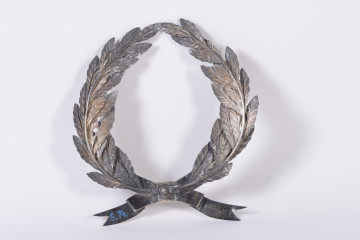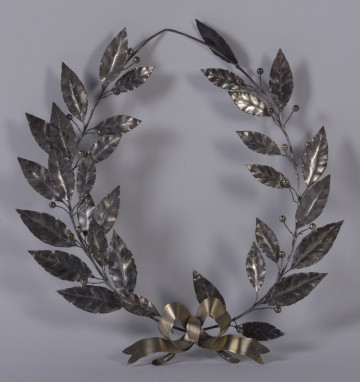
Laurel wreath
XIX/XX wiek
Castle Museum in Łańcut
Part of the collection: Metale
Goldsmithing: laurel wreath. Laurel wreath – a symbol of glory, fame, triumph and victory, also a reward for the victory in a battle or sports competition. It was awarded to victorious leaders, artists, poets, scholars, and athletes. Over time, the laurel wreath became a symbol not only of victory, but also of outstanding achievements in all areas of life. In the Middle Ages, graduates were honoured with branches of fruiting laurel. A laurel wreath was awarded to outstanding writers (the so-called Capitoline Laurel – a distinction awarded to writers by emperors or popes) (the so-called Capitoline Laurel– a distinction awarded to writers by emperors or popes)
In Christian art, laurel wreaths, as symbols of triumph and purity, adorned the heads of holy virgin-martyrs, as well as other martyrs. The laurel wreath also featured the monogram of Christ, indicating his victory over death, or the hand of God, which symbolized his immortality.
Laurel twigs and wreaths in funerary art are a symbol of immortality.
As a symbol of glory, the laurel wreath appeared in ancient Greece, but it was the Romans who popularized the custom of crowning emperors and victorious leaders, as well as eminent personalities of science and art, with laurels. Wreaths were also placed on the deceased. In this way, they were provided with the protection of the gods. It was supposed to protect the deceased from bad adventures in the afterlife.
The wreath comes from the collection of the Museum-Castle in Łańcut, from the collection of the Potocki family which was taken over in 1944. An elliptical wreath of bay leaves with fruit, tied at the bottom with a ribbon with an engraved inscription: "Od pracowników 1905 17 IX Antonin." The leaves are arranged according to gradations, from the largest to the smallest, lanceolate, stiff, with a delicately marked network of veins. The recorded date corresponds to the second anniversary of the death of Maria Klementyna Potocka, née Sanguszko - princess, wife of the governor of the Kingdom of Galicia and Lodomeria and diplomat Alfred Józef Potocki, who brought a huge dowry, consisting of the estates in Antoniny inherited from her grandparents. As the wife of the governor of the Kingdom of Galicia and Lodomeria, she organized balls, banquets and social gatherings. She was perceived as a meticulous person who could not tolerate insubordination. After her husband's death in 1889, she supervised the completion of the construction of the palace in Lviv, and handed over the estate in Antoniny to her younger son Józef. At the end of her life, she lived in Antoniny and Lviv, where she died on 17 October 1903.
Silver, Austria – Vienna, 45.2x34
Yulia Dushka
Author / creator
Object type
złotnictwo
Technique
wytłaczanie
Material
brown
Owner
Muzeum - Zamek w Łańcucie
Identification number
Location / status

XIX/XX wiek
Castle Museum in Łańcut

XIX/XX wiek
Castle Museum in Łańcut

Castle Museum in Łańcut
DISCOVER this TOPIC
National Museum in Szczecin
DISCOVER this PATH
Educational path